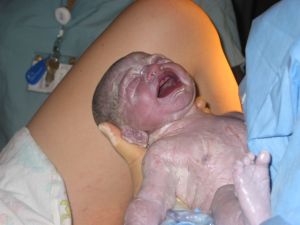By Rita Brhel, managing editor and attachment parenting resource leader (API)
 One in three women (31.8%) in America is now giving birth to their children via a Cesarean section. The highest rate in history for this nation, it is also much higher than the recommendation by the World Health Organization of 5% to 10% — not to mention that the rate of Cesarean sections in the U.S. has increased by 50% since 1996.
One in three women (31.8%) in America is now giving birth to their children via a Cesarean section. The highest rate in history for this nation, it is also much higher than the recommendation by the World Health Organization of 5% to 10% — not to mention that the rate of Cesarean sections in the U.S. has increased by 50% since 1996.
The U.S. began at 4.5% in 1965, the first year Cesarean section rates were measured here. At 15% or higher, Cesarean section rates indicate that this procedure is being done unnecessarily, according to a study highlighted by the article “Why the National U.S. C-Section Rate Keeps Rising” on www.childbirthconnection.org.
The article outlines several reasons for the increasing rate of this procedure. But, first, there are two widespread myths about the rise in Cesarean sections to counter:
- The number of women asking for an elective Cesarean section, without a medical reason, is NOT increasing; and
- The number of women who genuinely need a Cesarean section is NOT increasing.
In a 2005 survey by Childbirth Connection, it was found that only one in 1,600 respondents in the U.S. reported she had a planned Cesarean section with no medical reason, at her own request. The article cited a study that revealed this rate to be comparable with other countries.
Reasons given for the higher rates include women waiting to give birth when they’re older and more prone to developing medical complications, and more women giving birth to multiples. But the article reported that researchers show that the rate of Cesarean sections is going up for all women regardless of their age, health problems, race/ethnicity, or number of babies they are having.
What this means is that the reason behind the increasing rate of Cesarean sections is not on the part of the woman but rather lies with changing standards in the medical community. According to the Childbirth Connection survey, one in four respondents who had a Cesarean section said they received pressure from a medical professional to have the procedure.
According to the Childbirth Connection, here are the true reasons behind the increasing rates of Cesarean sections in the U.S.:
- Lower priority is being given to non-surgical methods of correcting potential birthing complications, such as turning a breech baby or encouraging labor progress through positioning and movement and comfort measures.
- Higher rates of labor intervention methods that make Cesarean sections more likely, including induction, getting an epidural early or without a high dose of oxytocin, and use of continuous electronic fetal monitoring.
- Fewer hospitals and/or medical doctors are willing to deliver a Vaginal Birth After Cesarean section, or VBAC. In fact, only one out of ten women who have had a previous Cesarean section has access to medical facilities and/or doctors who would allow a VBAC.
- The overall attitude toward Cesarean sections is that this procedure is no longer considered the major surgery that it is.
- Lower awareness of the increased risks associated with Cesarean sections over vaginal births, such as infection, surgical injury, blood clots, emergency hysterectomy, and intense and longer-lasting pain in recovery in mothers in the short term. In the long term, mothers are more likely to have ongoing pelvic pain, bowel blockage, infertility, and injury during future surgeries. Future pregnancies are more likely to be ectopic, result in uterine rupture, or have problems with placenta previa, accretia, and abruption. Babies born by Cesarean section are more likely to have surgical cuts, breathing problems, difficulty with breastfeeding, and childhood asthma.
- More doctors fear malpractice claims and lawsuits.
- More doctors are receiving incentives to practice more efficiently. Planned Cesarean sections can organize hospital work, office work, and the medical personnel’s personal lives. In addition, average hospital charges are much greater for Cesarean sections than for vaginal births, which mean more profit is gained by the Cesarean section.
About Childbirth Connection
Childbirth Connection is a national U.S. not-for-profit organization founded as the Maternity Center Association in 1918. Its mission is to improve the quality of maternity care through research, education, advocacy, and policy by promoting safe and effective, evidence-based maternity care and providing a voice for childbearing families. For more information, go to www.childbirthconnection.org.

